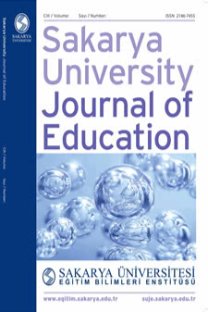Comparison of a more Effective and a Typical Teachers’ Lesson Plan Detail in the Psychological Engagement of Students
Comparison of a more Effective and a Typical Teachers’ Lesson Plan Detail in the Psychological Engagement of Students
___
- Almasi, J.F., & Fullerton, S.K. (2012). The strategic processes in reading. New York: The Guilford Press.
- Baecher, L., Famsworth, T., & Ediger, A. (2014). The challenges of planning language objectives in content-based ESL instruction. Language Teaching Research, 18(1), 118-136.
- Duffy, G.G. (1993). Teachers’ progress toward becoming expert strategy teachers. Elementary School Journal, 94(2), 109-120. doi: 10.1086/461754
- Duke, N., Pearson, D., Strachan, S., & Billman, S. (2011). Essential elements of fostering and teaching reading comprehension. In S. Samuels & A. Farstrup (eds.), What Research Has to Say About Reading Instruction (4th ed.,pp. 51-93). Newark: DE: International Reading Association.
- Flurkey, A., & Xu, J., (Eds.) (2003). On the revolution of reading: The selected writings of Kenneth S. Goodman. Portsmouth, NH: Heinemann.
- Ghorbani, M.R., Gangeraj, A.A., & Alavi, S.Z. (2013). Reciprocal teaching of comprehension strategies improves EFL learners’ writing ability. Current Issues in Education, 16(1), 1-11.
- Guthrie, J. T., McRae, A., & Klauda, S. L. (2007). Contributions of concept-oriented reading instruction to knowledge about interventions for motivations in reading. Educational Psychology, 42(4),237–250.
- John, P.D. (2006). Lesson planning and the student teacher: Re-thinking the dominant model. Journal of Curriculum Studies, 38(4), 483-498.
- Kim, W., Linan-Thompson, S., & Misquitta, R. (2012). Critical factors in reading comprehension instruction for students with learning disabilities: A research synthesis. Learning Disabilities Research & Practise, 27(2), 66-78.
- Kintsch, W. (2005). An Overview of Top-Down and Bottom-Up Effects in Comprehension: The CI Perspective. Discourse Processes: A Multidisciplinary Journal, 39(2&3), 125-128. doi: 10.1207/s15326950dp3902&3_2
- Korkut, P. (2018). The construction and pilot application of a scoring rubric for creative drama lesson planning. The Journal of Applied Theatre and Performance, 23(1), 114-125. doi: 10.1080/13569783.2017.1396211
- Kymes, A. (2005). Teaching online comprehension strategies using think-alouds. Journal of Adolescent and Adult Literacy, 48(6), 492-500. doi: 10.1598/JAAL.48.6.4
- Lane, J. S. (2010). An analysis of relationships between lesson planning training and rehearsal. Journal of Band Research, 46(1), 52-65.
- Leslie, L., & Caldwell, J. S. (2010). Qualitative Reading Inventory – 5. Boston: Pearson. Mason, L.H. (2004). Explicit self-regulated strategy development versus reciprocal questioning: Effects on expository reading comprehension among struggling readers. Journal of Educational Psychology, 96(2), 283-296. doi: 10.1037/0022-0663.96.2.283
- Migyanka, J. M., Policastro, C., & Guiqiu, L. (2005). Using a think-aloud with diverse students: Three primary grade students experience chrysanthemum. Early Childhood Education Journal, 33(3), 171-177. doi: 10.1007/s10643-005-0045-z
- Mitchell, K. E. (2006). Getting to the Heart of a Story. Teaching Pre K-8, 37(1), 66-67.
- Morrow, L. M. (2011). Developing effective reading curricula for beginning readers and the primary grades. In T. V. Rasinski (Ed.), Rebuilding the foundation: Effective reading instruction for 21st century literacy (pp. 89–112). Bloomington, IN: Solution Tree Press.
- National Reading Panel (2000). Teaching children to read: An evidence-based assessment of the scientific research literature on reading and its implications for reading instruction.
- Washington, D.C.: National Institute of Child Health and Human Development.
- Ness, M. (2011). Explicit reading comprehension instruction in elementary classrooms: Teacher use of reading comprehension strategies. Journal of Research in Childhood Education, 25(1), 98-117. doi: 10.1080/02568543.2010.531076
- Palincsar, A.S., & Brown, A.L. (1984). Reciprocal teaching of comprehension-fostering and comprehension-monitoring activities. Cognition and Instruction, 1(2), 117-175. doi: 10.1207/s1532690xci0102_1
- Pardo, L. S. (2004). What every teacher needs to know about comprehension. The Reading Teacher, 58(3), 272-280. doi: 10.1598/RT.58.3.5
- Parker, E. C., Bond, V. L., & Powell, B. S. (2017). A grounded theory of preservice music educators’ lesson planning processes within field experiences methods courses. Journal of Research in Music Education, 65(3), 287-308. doi: 10.1177/0022429417730035
- Peterson, P.L., Marx, R.W., Clark, C.M. (1978). Teacher planning, teacher behavior, and student achievement. American Educational Journal, 15(3), 417-432.
- Regan, K. S., Evmenova, A. S., Kurz, L. A., Hughes, M. D., Sacco, D., Ahn, S. Y., MacVittie, N., Good, K., Boykin, A., Schwartzer, J., Chirinos, D. S. (2016). Researchers apply lesson study: A cycle of lesson planning, implementation, and revision. Learning Disabilities Research & Practise, 31(2), 113-122. doi: 10.1111/ldrp.12101
- Schmidt, M. (2005). Preservice string teachers’ lesson-planning processes: An exploratory study. Journal of Research in Music Education, 53, 6-25. doi: 10.1177/002242940505300102
- Stone, A. (1998). The metaphor of scaffolding: Its utility for the field of learning disabilities. Journal of Learning Disabilities, 31(4), 344-364. doi: 10.1177/002221949803100404
- Townsend, D., & Boynton, M.J. (2013). Mediating the effects of reading engagement on reading comprehension of early adolescent English language learners. Reading & Writing Quarterly, 29, 309-332.
- Watson, S. R., Gable, R. A., Gear, S. B., & Hughes, K. C. (2012). Evidence-based strategies for improving the reading comprehension of secondary students: Implications for students with learning disabilities. Learning Disabilities Research & Practise, 27(2), 79-89. doi: 10.1111/j.1540-5826.2012.00353.
- Woodcock, R.W., McGrew, K. S., &Mather, N. (2001). Woodcock-Johnson III. Circle Pines, MN: American Guidance Services.
- Yaqoob, L.H. (2020). Mim Harfi uzerinden bir dil felsefesi denemesi [An essay on a philosophy of language on the Letter Mim]. Muarrib yayinlari.
- Zahorik, J.A. (1970). The effect of planning on teaching. The Elementary School Journal, 71(3), 143- 151.
- ISSN: 2146-7455
- Yayın Aralığı: Yılda 3 Sayı
- Başlangıç: 2011
- Yayıncı: Sakarya Üniversitesi Eğitim Bilimleri Enstitüsü
Murat TOPAL, Özcan Erkan AKGÜN
Özgür DEMİRCİ SEYREK, Kurtman ERSANLI
Fatima Zehra ALLAHVERDİ, Lynn GELZHEİSER
Lynn GELZHEİSER, Fatima Zehra ALLAHVERDİ
Öğretmen Adaylarının Fen Öğretimine Yönelik Öz-Yeterlik İnancı (FÖYÖİ) Bileşenlerinin İncelenmesi
Dilber POLAT, Gülşah ULUAY, Uğur BAŞARMAK
Selman CUTUK, Zülbiye KAÇAY, Zeynep AKKUŞ ÇUTUK
Şefika Şule ERÇETİN, Nilüfer KOÇTÜRK, Nihan POTAS, Şuay Nilhan AÇIKALIN, Sema ABAL
The Relationship Between Prosocial and Antisocial Behaviors and Personality Traits in Team Athletes*
Zeynep AKKUŞ ÇUTUK, Zülbiye KAÇAY, Selman ÇUTUK
Middle-School Students’ Perceptions of History of Science
Muhammet Emin MISIR, Onur ADIGÜZEL
İlköğretim Öğretim Programlarının Felsefi Temelleri Hakkında Öğretmen Görüşleri
